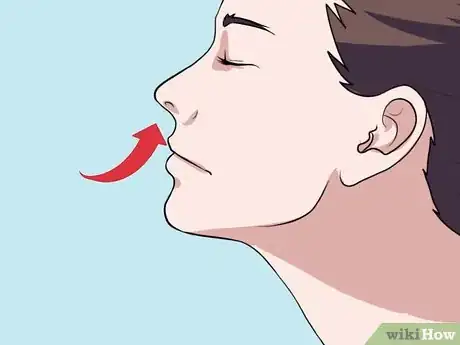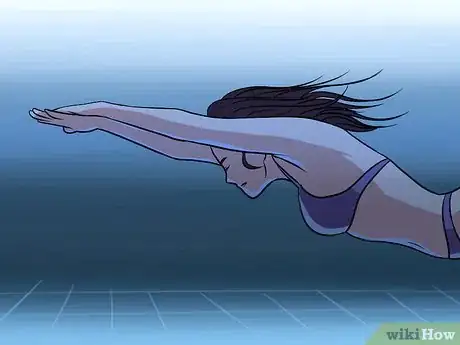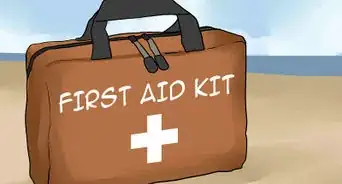This article was co-authored by Brad Hurvitz. Brad Hurvitz is a Certified Swimming Instructor for My Baby Swims, an adolescent swimming school based in La Jolla, California. Brad is trained as an Infant Swimming Resource (ISR) instructor with ISR's Self-Rescue® program. He specializes in training children aged six months to six years of age survival skills like floating on their back to breathe and swimming back to the wall, while also educating parents on how to better keep their kids safe. He has a Master of Business Administration from Oregon State University.
There are 11 references cited in this article, which can be found at the bottom of the page.
This article has been viewed 201,402 times.
Maybe you'd like to stay underwater for a length of time to outsmart others in a pool game or you’d just like to get a different perspective on the world around you. While it is dangerous to hold your breath for too long underwater, you can stay underwater easily with thorough preparation.
Steps
Preparing to Stay Submerged
-
1Determine how long you can hold your breath out of water. Stand or sit still. Breathing slowly and deeply, take several full breaths. At the top of an inhale, hold your breath by closing the back of your throat. Use a stopwatch to time how long you can hold your breath. If you're happy with the time, you may feel ready to hit the pool. If not, you can increase your lung strength and capacity through breathing exercises and regular physical activity.
- You may have heard that people can hold their breath underwater for several minutes. This is thanks to the mammalian diving reflex, which makes it possible for mammals to hold their breath longer underwater than on land. This is a survival instinct and is not to be relied upon. Further, people who set records for holding their breath regularly practice their endurance and do so under particular conditions.[1]
-
2Practice diaphragmatic breathing. Just because you are constantly breathing doesn't mean you are getting the most out of your breath. Abdominal breathing exercises that strengthen your lungs and diaphragm, the muscle that separates the chest cavity from the abdomen, can help you to breathe more consciously and efficiently.[2]
- Lie down on a flat surface. Use a pillow under your head if desired, and/or under your knees, if you have pain in your low back.
- Place one hand on your chest, in the area of your heart, and the other just below your rib cage.
- Breathe in slowly through your nose. The hand on your belly should rise, but the hand on your chest should remain still.
- Contract your stomach muscles and exhale slowly for six seconds through puckered lips. Again, the hand on your chest should remain still throughout the exhale.
- Practice this sequence 5-10 minutes a few times a day. As the exercise becomes more habitual and easy, you may place a book, bag of rice, or sandbag (available at yoga supply stores) on your abdomen to increase the strength of your diaphragm.
Advertisement -
3Engage in regular cardiovascular exercise. This is exercise that increases your heart rate. Improved cardio-respiratory function and more efficient use of oxygen are some of the benefits of a regular fitness routine. For general health, adults are advised to get 30 minutes or more of moderate physical exercise most days of the week.[3]
- Running, biking, swimming, aerobics classes, and even dancing are all aerobic activities. Try multiple activities to identify an exercise that is enjoyable to you. If you enjoy an exercise activity, you will more likely stick to it.
- Establish an exercise routine. Routines help make exercise into a regular habit. Try working out at various times in the day and evening to determine when it is most convenient for you to exercise.
- Even small amounts of physical activity, e.g., five to ten minutes of walking, can improve your physical health. Aim to accumulate a total of 30 minutes of exercise a day.[4]
-
4Find out if holding your breath for a long period is allowed at the pool you will be using. Many public pools in the United States have banned long breath-holding because of the risk of hypoxia (low oxygen), which can impair brain function, cause unconsciousness, and death.[5]
Sinking to the Bottom of the Pool
-
1Choose a spot in the water to sink. You can completely submerge yourself in any body of water that is higher than you are tall, or that will cover your head when sitting (or even lying down, such as in a wading pool). The most important factor to consider for picking a spot is to observe your surroundings. Always approach holding your breath underwater with caution, especially in a crowded public pool where people are engaged in many different activities and not paying attention to others.
- If you want to sink to the bottom of a pool, you may think choosing a spot near the wall is safest. But, remember that people will be entering the water around all edges of a pool. It may be better to find a relatively isolated place, away from where people may be entering the water and away from large groups. Also, keep your distance from the pool drain, which can exert hundreds of pounds of suction and can cause injury and death.[6] Have a friend keep an eye out for you while you’re below the surface.
- If you’re swimming underwater, keep an eye out for traffic and remember that other swimmers will not necessarily be looking out for you. Ideally you can chart a clear path ahead of you to the other side, one that will stay clear until you get there.
-
2Take a vertical position in the water with your feet pointing down. If you're in the shallow side of the pool, you will likely be standing. If you're in a part of the pool where the water is higher than you are tall, your body will assume a vertical position with ease as, generally, your lower body will be heavier than your upper body. [7]
-
3Take some slow, deep breaths to fill your lungs with oxygen. Do not hyperventilate. Taking several fast breaths in a row before submerging yourself is known as DUBB, "dangerous underwater breath-holding behaviors" and can cause hypoxic blackout, which can lead to brain damage, fainting, and death.[8]
-
4Get into a tucked position. Pull your knees in and hold them close to your chest by wrapping your arms around them. This tucked position changes the amount of space you're taking up in the water and will allow you to fall deeper into the water and to more easily remain underwater.
- Objects, and bodies, sink in water if they have a higher density than the body of water. An object's density depends on its mass and volume--the amount of space it takes up.[9] As such, taking up less space in the water will help you sink.
-
5Sink. Release air bubbles slowly through your nose. You can let them out of your mouth as well and they can be bigger, but you'll sink faster. You may also do both and let out small bits of air, puffing your cheeks between blowing air out. Let your head and body sink into the water. When your feet hit the bottom of the pool, sit in a comfortable position, such as cross-legged or holding on to your knees in front of you.
-
6Return to the surface. When you’re ready or running out of breath, look up to make sure nothing and no one is in your way to the pool’s surface. Whether seated or standing, press firmly into your feet and stretch your arms skyward to shoot or swim upwards.
Swimming the Length of the Pool Underwater
-
1Take several, slow deep breaths to fill your lungs with oxygen. Remember to avoid hyperventilating--taking quick or shallow breaths. This behavior is dangerous because your body will lose oxygen more quickly and you may suffer hypoxic blackout and even death.[10]
-
2Submerge your head and body in a streamlined position. As you fall below the surface of the water, assume a horizontal position parallel to the pool floor. Keep your head and eyes in a neutral position facing the bottom of the pool and bring your arms up over your head, squeezing them alongside your ears.[11]
-
3Use your feet to push strongly off the wall. Keep your torso and arms in a streamlined position, bend your knees, and plant both of your feet on the wall. Press firmly into both of your feet to push you forward and give your body momentum.
-
4Use dolphin kick to propel you across the water. This kick is considered the most powerful for swimming underwater. Keep your legs and feet together and bend your knees slightly. Kick both legs forward simultaneously, finishing with them slightly in front of the body. Repeat until you reach the other side of the pool, coming up for air if necessary.[12]
- The power of dolphin kick comes from moving your legs like a whip. Focus on fully extending your legs to get the most power from the kick.
-
5Keep your hands and arms in front of you as you swim. This streamlined position is the most efficient for cutting through the water as quickly as possible and will alert you to obstacles ahead of you.[13]
-
6Emerge from the water. When your hands meet the pool wall, use them to push against the wall to bring you to the surface.
Community Q&A
-
QuestionIf I open my eyes underwater, will it make my eyes burn?
 Community AnswerIt depends on how much chlorine in the pool, and how sensitive you are to it. It's quite possible your eyes will feel irritated for a while.
Community AnswerIt depends on how much chlorine in the pool, and how sensitive you are to it. It's quite possible your eyes will feel irritated for a while. -
QuestionHow do I swim on the surface of the water without sinking?
 Community AnswerI find that spreading my legs and arms out (almost like a starfish) helps, as well as taking a deep breath before entering. If you can, try floating on your back, breathing, and then turning over.
Community AnswerI find that spreading my legs and arms out (almost like a starfish) helps, as well as taking a deep breath before entering. If you can, try floating on your back, breathing, and then turning over. -
QuestionHow do I stay underwater without floating back up to the surface?
 Community AnswerFirst, take a deep breath. Then get into the water. Slowly let air out of your lungs until you begin to sink.
Community AnswerFirst, take a deep breath. Then get into the water. Slowly let air out of your lungs until you begin to sink.
Warnings
- Holding your breath underwater can cause drowning due to low oxygen, which can quickly lead to death. Unintentional drowning is a leading cause of death in the United States, especially for children.[14] Be aware that people drown in shallow water every year and that many government agencies and non-profits around the world are engaged in educational campaigns to raise awareness about the dangerous consequences of holding your breath underwater. For safety, always have someone you know nearby keeping an eye on you.⧼thumbs_response⧽
References
- ↑ http://www.dailymail.co.uk/news/article-2157442/How-CAN-man-hold-breath-22-minutes-The-amazing-feat-world-record-holder-Tom-Sietas-explained.html
- ↑ http://my.clevelandclinic.org/health/diseases_conditions/hic_Understanding_COPD/hic_Pulmonary_Rehabilitation_Is_it_for_You/hic_Diaphragmatic_Breathing
- ↑ http://www.scientificamerican.com/article/if-a-persons-lung-size-ca/
- ↑ http://www.webmd.com/fitness-exercise/guide/fitness-beginners-guide
- ↑ http://www.reuters.com/article/2015/05/29/us-usa-drowning-pools-idUSKBN0OE16D20150529
- ↑ http://www.nydailynews.com/life-style/health/prevent-pool-accidents-usher-son-article-1.1421524
- ↑ http://www.swim-teach.com/how-do-I-float.html
- ↑ http://www.cdc.gov/mmwr/preview/mmwrhtml/mm6419a3.htm
- ↑ http://www.scientificamerican.com/article/muscle-versus-fat/
- ↑ http://www.cdc.gov/mmwr/preview/mmwrhtml/mm6419a3.htm
- ↑ Brad Hurvitz. Certified Survival Swimming Instructor. Expert Interview. 13 February 2020.
- ↑ Brad Hurvitz. Certified Survival Swimming Instructor. Expert Interview. 13 February 2020.
- ↑ Brad Hurvitz. Certified Survival Swimming Instructor. Expert Interview. 13 February 2020.
- ↑ http://www.cdc.gov/HomeandRecreationalSafety/Water-Safety/waterinjuries-factsheet.html
About This Article
To stay underwater in a swimming pool, start by wrapping your arms around your legs so your knees are against your chest, which will help you sink. Then, slowly release air bubbles through your nose so you sink deeper into the pool. Keep doing this until you reach the bottom of the pool. Once you reach the bottom, sit cross-legged or hold onto your knees in front of you. When you're ready to come up, stretch out your arms and legs and swim toward the surface. To learn how to swim the length of a swimming pool while underwater, read on!













































































